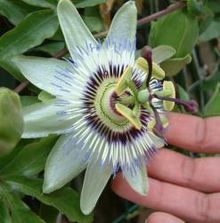| Passifloraceae | |
|---|---|

| |
| Passiflora caerulea | |
| Scientific classification | |
| Kingdom: | Plantae |
| Clade: | Tracheophytes |
| Clade: | Angiosperms |
| Clade: | Eudicots |
| Clade: | Rosids |
| Order: | Malpighiales |
| Family: | Passifloraceae Juss. ex Roussel[1][2] |
| Subfamilies | |
| Synonyms | |
| |
The Passifloraceae are a family of flowering plants, containing about 750 species classified in around 27 genera.[1]
They include trees, shrubs, lianas, and climbing plants, and are mostly found in tropical regions. The family takes its name from the passion flower genus (Passiflora) which includes the edible passion fruit (Passiflora edulis), as well as garden plants such as maypop and running pop.
Passiflora vines and Dryas iulia (among other heliconian butterflies) have demonstrated evidence of coevolution, in which the plants attempted to stop their destruction from larval feeding by the butterflies, while the butterflies tried to gain better survival for their eggs.[3]
The former Cronquist system of classification placed this family in the order Violales, but under more modern classifications systems such as that proposed by the Angiosperm Phylogeny Group, this is absorbed into the Malpighiales and the family has been expanded to include the former Malesherbiaceae and Turneraceae.
Genera[edit]
Subfamily Malesherbioideae[edit]
- Malesherbia Ruiz & Pav.
Subfamily Pibirioideae[edit]
- Pibiria Maas
Subfamily Passifloroideae[edit]
|
Subfamily Turneroideae[edit]
|
Excluded genera[edit]
- Abatia Ruiz & Pav. → Salicaceae
- Aphaerema Miers → Salicaceae[6]
Phylogeny[7][edit]
|
Violaceae | |||||||||||||||||||
| Outgroup | |||||||||||||||||||
| |||||||||||||||||||
References[edit]
- ^ a b c d "Family: Passifloraceae Juss. ex Roussel, nom. cons". Germplasm Resources Information Network. United States Department of Agriculture. 2003-01-17. Archived from the original on 2015-09-23. Retrieved 2012-01-10.
- ^ Angiosperm Phylogeny Group (2009). "An update of the Angiosperm Phylogeny Group classification for the orders and families of flowering plants: APG III" (PDF). Botanical Journal of the Linnean Society. 161 (2): 105–121. doi:10.1111/j.1095-8339.2009.00996.x. hdl:10654/18083. Retrieved 2013-07-06.
- ^ Benson, WW; Brown, S Jr; Gilbert, LE (1975). "Coevolution of plants and herbivores". Evolution. 29 (4): 659–680. doi:10.2307/2407076. JSTOR 2407076. PMID 28563089.
- ^ "Smeathmannia R.Br. | Plants of the World Online | Kew Science". Plants of the World Online. Retrieved 7 January 2022.
- ^ "GRIN Genera of Passifloraceae". Germplasm Resources Information Network. United States Department of Agriculture. Archived from the original on 2015-09-24. Retrieved 2012-01-10.
- ^ "GRIN genera sometimes placed in Passifloraceae". Germplasm Resources Information Network. United States Department of Agriculture. Archived from the original on 2015-09-24. Retrieved 2012-01-10.
- ^ Maas, Paul J M; Baas, Pieter; Christenhusz, Maarten J M; Clarkson, James J; Koek-Noorman, Jifke; Mennega, Alberta M W; Tokuoka, Toru; Van Der Bank, Michelle; Van Der Ham, Raymond W J M; Van Marle, Erik-Jan; Westra, Lubbert Y T H; Chase, Mark W (2019-03-26). "'Unknown yellow':Pibiria, a new genus of Passifloraceae with a mixture of features found in Passifloroideae and Turneroideae". Botanical Journal of the Linnean Society. 189 (4): 397–407. doi:10.1093/botlinnean/boz003. ISSN 0024-4074.
External links[edit]
 Media related to Passifloraceae at Wikimedia Commons
Media related to Passifloraceae at Wikimedia Commons Data related to Passifloraceae at Wikispecies
Data related to Passifloraceae at Wikispecies- Passiflora Online
- The Passiflora Society International
- Passiflora Picture Gallery